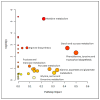Metabolite, Biochemical, and Dietary Intake Alterations Associated with Lifestyle Interventions in Obese and Overweight Malaysian Women
- PMID: 39458496
- PMCID: PMC11510420
- DOI: 10.3390/nu16203501
Metabolite, Biochemical, and Dietary Intake Alterations Associated with Lifestyle Interventions in Obese and Overweight Malaysian Women
Abstract
Differences in metabolic regulation among obesity phenotypes, specifically metabolically healthy obese (MHO) and metabolically unhealthy obese (MUO) women, may lead to varied responses to interventions, which could be elucidated through metabolomics. Therefore, this study aims to investigate the differences in metabolite profiles between MHO and MUO women and the changes following a lifestyle intervention. Serum samples from 36 MHO and 34 MUO women who participated in a lifestyle intervention for weight loss were analysed using untargeted proton nuclear magnetic resonance spectroscopy (1H NMR) at baseline and 6 months post-intervention. Anthropometric, clinical, and dietary intake parameters were assessed at both time points. Both groups showed differential metabolite profiles at baseline and after six months. Seven metabolites, including trimethylamine-N-oxide (TMAO), arginine, ribose, aspartate, carnitine, choline, and tyrosine, significantly changed between groups post-intervention, which all showed a decreasing pattern in MHO. Significant reductions in body weight and body mass index (BMI) in the MUO correlated with changes in the carnitine and tyrosine levels. In conclusion, metabolite profiles differed significantly between MHO and MUO women before and after a lifestyle intervention. The changes in carnitine and tyrosine levels in MUO were correlated with weight loss, suggesting potential targets for therapeutic intervention.
Keywords: NMR; lifestyle intervention; metabolically healthy obese; metabolomics; obesity.
Conflict of interest statement
The authors declare no conflicts of interest.
Figures





Similar articles
-
Lifestyle Behaviors in Metabolically Healthy and Unhealthy Overweight and Obese Women: A Preliminary Study.PLoS One. 2015 Sep 18;10(9):e0138548. doi: 10.1371/journal.pone.0138548. eCollection 2015. PLoS One. 2015. PMID: 26383251 Free PMC article.
-
A comprehensive metabolic profiling of the metabolically healthy obesity phenotype.Lipids Health Dis. 2020 May 9;19(1):90. doi: 10.1186/s12944-020-01273-z. Lipids Health Dis. 2020. PMID: 32386512 Free PMC article. Clinical Trial.
-
Metabolically Healthy Obesity (MHO) vs. Metabolically Unhealthy Obesity (MUO) Phenotypes in PCOS: Association with Endocrine-Metabolic Profile, Adherence to the Mediterranean Diet, and Body Composition.Nutrients. 2021 Nov 2;13(11):3925. doi: 10.3390/nu13113925. Nutrients. 2021. PMID: 34836180 Free PMC article.
-
Are we close to defining a metabolomic signature of human obesity? A systematic review of metabolomics studies.Metabolomics. 2019 Jun 13;15(6):93. doi: 10.1007/s11306-019-1553-y. Metabolomics. 2019. PMID: 31197497 Free PMC article.
-
Metabolomic Signature Between Metabolically Healthy Overweight/Obese and Metabolically Unhealthy Overweight/Obese: A Systematic Review.Diabetes Metab Syndr Obes. 2021 Mar 4;14:991-1010. doi: 10.2147/DMSO.S294894. eCollection 2021. Diabetes Metab Syndr Obes. 2021. PMID: 33692630 Free PMC article. Review.
Cited by
-
Metabolomics: Uncovering Insights into Obesity and Diabetes.Int J Mol Sci. 2025 Jun 27;26(13):6216. doi: 10.3390/ijms26136216. Int J Mol Sci. 2025. PMID: 40649995 Free PMC article.
References
-
- World Health Organization Obesity and Overweight Fact Sheets. [(accessed on 10 June 2024)]. Available online: https://www.who.int/news-room/fact-sheets/detail/obesity-and-overweight.
-
- Institute for Public Health National Health and Morbidity Survey (NHMS) 2023 Fact Sheet. [(accessed on 10 June 2024)]; Available online: https://iku.gov.my/nhms-2023.
-
- Palau-Rodriguez M., Garcia-Aloy M., Minarro A., Bernal-Lopez M.R., Brunius C., Gomez-Huelgas R., Landberg R., Tinahones F.J., Andres-Lacueva C. Effects of a long-term lifestyle intervention on metabolically healthy women with obesity: Metabolite profiles according to weight loss response. Clin. Nutr. 2020;39:215–224. doi: 10.1016/j.clnu.2019.01.018. - DOI - PubMed
MeSH terms
Substances
Grants and funding
LinkOut - more resources
Full Text Sources
Medical

